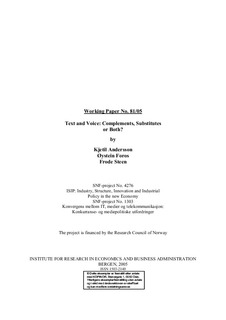| dc.contributor.author | Andersson, Kjetil | |
| dc.contributor.author | Foros, Øystein | |
| dc.contributor.author | Steen, Frode | |
| dc.date.accessioned | 2006-06-23T11:59:39Z | |
| dc.date.available | 2006-06-23T11:59:39Z | |
| dc.date.issued | 2005 | |
| dc.identifier.issn | 1503-2140 | |
| dc.identifier.uri | http://hdl.handle.net/11250/166470 | |
| dc.description.abstract | Text messaging has become an important revenue component for European and Asian mobile operators. We develop a simple model of demand for mobile services incorporating the existence of call externalities and network effects. We show that when incoming messages and calls stimulate outgoing communications, services that are perceived as substitutes, such as mobile text and voice, may evolve into complements in terms of the price effect when the network size becomes large. We estimate the demand for text messaging in the Norwegian market and find that the cross-price effect of voice depends on the network size. Voice is a substitute for text messages for small network sizes, and a complement for large network sizes. | en |
| dc.format.extent | 124175 bytes | |
| dc.format.mimetype | application/pdf | |
| dc.language.iso | eng | en |
| dc.publisher | SNF | en |
| dc.relation.ispartofseries | Working paper | en |
| dc.relation.ispartofseries | 2005:81 | en |
| dc.subject | text messaging | en |
| dc.subject | cross-price elasticity | en |
| dc.subject | call externalities | en |
| dc.subject | positive feedback effects | en |
| dc.subject | network effects | en |
| dc.title | Text and voice : complements, substitutes or both? | en |
| dc.type | Working paper | en |
